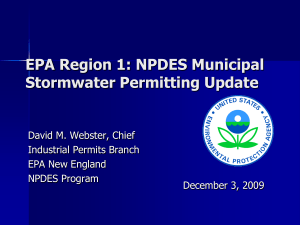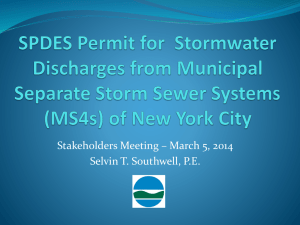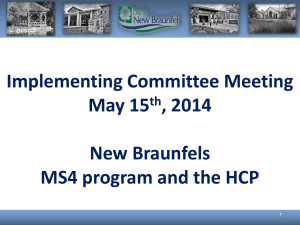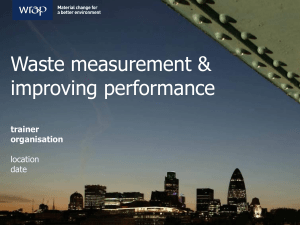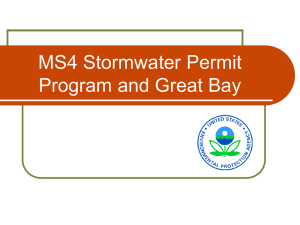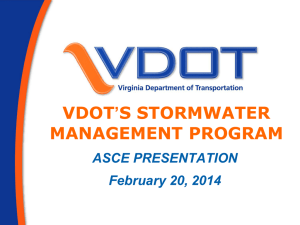Small MS4 Annual Report
advertisement
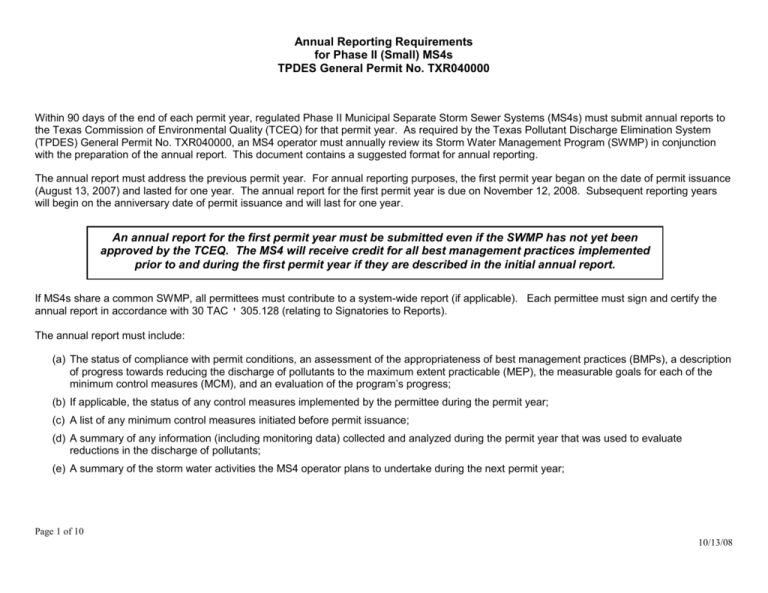
Annual Reporting Requirements for Phase II (Small) MS4s TPDES General Permit No. TXR040000 Within 90 days of the end of each permit year, regulated Phase II Municipal Separate Storm Sewer Systems (MS4s) must submit annual reports to the Texas Commission of Environmental Quality (TCEQ) for that permit year. As required by the Texas Pollutant Discharge Elimination System (TPDES) General Permit No. TXR040000, an MS4 operator must annually review its Storm Water Management Program (SWMP) in conjunction with the preparation of the annual report. This document contains a suggested format for annual reporting. The annual report must address the previous permit year. For annual reporting purposes, the first permit year began on the date of permit issuance (August 13, 2007) and lasted for one year. The annual report for the first permit year is due on November 12, 2008. Subsequent reporting years will begin on the anniversary date of permit issuance and will last for one year. An annual report for the first permit year must be submitted even if the SWMP has not yet been approved by the TCEQ. The MS4 will receive credit for all best management practices implemented prior to and during the first permit year if they are described in the initial annual report. If MS4s share a common SWMP, all permittees must contribute to a system-wide report (if applicable). Each permittee must sign and certify the annual report in accordance with 30 TAC ' 305.128 (relating to Signatories to Reports). The annual report must include: (a) The status of compliance with permit conditions, an assessment of the appropriateness of best management practices (BMPs), a description of progress towards reducing the discharge of pollutants to the maximum extent practicable (MEP), the measurable goals for each of the minimum control measures (MCM), and an evaluation of the program’s progress; (b) If applicable, the status of any control measures implemented by the permittee during the permit year; (c) A list of any minimum control measures initiated before permit issuance; (d) A summary of any information (including monitoring data) collected and analyzed during the permit year that was used to evaluate reductions in the discharge of pollutants; (e) A summary of the storm water activities the MS4 operator plans to undertake during the next permit year; Page 1 of 10 10/13/08 (f) Proposed changes to the SWMP, including changes to any BMPs or any identified measurable goals that apply to the program elements; (g) The number of municipal construction activities authorized under this general permit and the total number of acres disturbed; (h) The number of non-municipal construction activities that occurred within the jurisdiction of the permittee (as noticed to the permittee by the construction operators); and (i) If applicable, notification that the MS4 operator is relying on another government entity to satisfy some of its permit obligations. The annual report must be submitted to the following address: Texas Commission on Environmental Quality Storm Water & Pretreatment Team; MC - 148 P.O. Box 13087 Austin, Texas 78711-3087 A copy of the annual report must also be submitted to the TCEQ Regional Office. To locate the TCEQ Regional Office that serves the area of the regulated small MS4, visit http://www.tceq.state.tx.us/about/directory/region/reglist.html. Page 2 of 10 10/13/08 Phase II (Small) MS4 Annual Report TPDES General Permit No. TXR040000 INSTRUCTIONS A. General Information 1. Provide the name of the permittee (municipality or owner/operator of the MS4). 2. Provide the beginning and end dates of the annual reporting period (permit year). 3. Provide the name, telephone number, and email address for the storm water program contact person. B. SWMP Modifications and Additional Information 1. If changes have been made or are proposed to the SWMP. Modifications to the SWMP must be addressed in the annual report in as required in Part II Section D 3 of the permit. If the TCEQ has notified you in writing that changes to the SWMP are necessary, those changes must be included in the report. Be sure to provide the following information in the explanation: Describe changes made to BMPs, measurable goals, dates, contacts, procedures or details during the permit year. If changes include additions or substitutions of BMPs, include a written analysis explaining why the original BMP is ineffective or not feasible and why the replacement BMP is expected to achieve the goals of the original BMP. NOTE: If the SWMP has not been approved, the MS4 operator should send a letter to the TCEQ permit writer so that changes may be considered during the SWMP review process. Because no SWMP was approved during the first permit year, a Notice of Change (NOC) form is not applicable. The NOC is required if revisions are proposed to a SWMP that has already been approved by the TCEQ. 2. If the MS4 has annexed land. Attach a description (or map) indicating the newly annexed area located within a regulated area, the BMPs to be implemented, and any resulting updates to the SWMP. 3. If the receiving water body is newly listed as impaired or a Texas Maximum Daily Load (TMDL) has been established. Refer to Part II Section C of general permit TXR040000 for additional information about limitations on permit coverage, compliance with water quality standards, and prohibited discharges (Edwards Aquifer Recharge Zone, specific watersheds, etc.). a. Impaired waters are those that do not meet applicable water quality standards and are listed on the Clean Water Act § 303(d) list. Constituents of concern are those for which the water body is listed as impaired. New sources or new discharges of the constituent(s) of concern to impaired waters are not authorized by the permit unless otherwise allowable under 30 TAC Chapter 305 and applicable state law. To determine if your receiving water has been listed as impaired, refer to the Texas 2008 List of Impaired Waters on the TCEQ web site at: http://www.tceq.state.tx.us/compliance/monitoring/water/quality/data/08twqi/twqi08.html b. A TMDL is the maximum amount of a water quality contaminant that can be discharged into a body of surface water on a daily basis without causing an exceedance of surface water quality standards. More information about TMDLs is located on the TCEQ web site at: http://www.tceq.state.tx.us/implementation/water/tmdl/tmdlprogram.html Page 3 of 10 10/13/08 NOTE: Discharges of constituent(s) of concern to impaired water bodies for which there is a TMDL implementation plan are not eligible for coverage under this general permit unless they are consistent with the approved TMDL and the implementation plan. In order to be eligible for permit coverage, MS4 operators must incorporate into their SWMP the limitations, conditions and requirements applicable to their discharges, including monitoring frequency and reporting as required by the TCEQ rules. For discharges not eligible for coverage under this general permit, the discharger must apply for and received an individual TPDES permit. 4. If the MS4 conducted analytical monitoring of storm water. Attach to the annual report any monitoring data used to evaluate the success of the SWMP at reducing pollutants to the maximum extent practicable. The data summary should include a discussion of results. 5. If the MS4 is relying on another government entity to satisfy some of the permit obligations. If you are relying on another entity to satisfy permit obligations, attach a statement to the annual report identifying the entity and the elements of the SWMP that the entity will be implementing. A description of the agreement or written documentation of the agreement should be included in the SWMP. C. Storm Water Management Program Status Each MS4 is required to evaluate compliance with permit requirements and assess the appropriateness of the BMPs in reducing the discharge of pollutants to the maximum extent practicable. The purpose of the annual report is to describe the status of compliance with permit conditions – specifically the implementation of selected BMPs and the progress towards achieving the measurable goals for each BMP. Using the example table provided below, summarize the status of all BMPs specified in the SWMP, as follows: Minimum Control Measures: Specify the MCM addressed by each BMP. The six MCMs are listed in Part III A of the permit. Some BMPs may address more than one MCM. Include at least one BMP for each MCM. Best Management Practices: BMPs are the specific long-term activities and practices that will be implemented to prevent or reduce storm water pollution. Examples include public service announcements, outfall inspections, and construction site plan reviews. List all of the BMPs specified in the SWMP, including any new BMPs. Measurable Goals: Measurable goals are the ongoing tasks and interim steps that demonstrate progress toward implementing a specific BMP. List all measurable goals from the SWMP, and include any new measurable goals. If you have developed a storm water ordinance during the permit year, include a description or citation of the ordinance, or simply attach a copy of the ordinance. New or Revised: Indicate whether the BMP or measurable goal is new or revised. Examples include replacement of a BMP with another, addition of a new measurable goal, revision of a start date, etc. Briefly explain the change. Start Date: Specify the scheduled start date (month and year) for each BMP as described in the schedule provided in the SWMP. Implementation Status: Describe the implementation status (such as completed, in progress, or not started) of each BMP as of the end of the permit year. If an activity has been completed, indicate the completion date. If an activity has not yet been started or is in progress, provide the expected completion date. Briefly describe the frequency with which ongoing BMPs are conducted. The following table is an example of the type of information to be provided in the annual report: Page 4 of 10 10/13/08 EXAMPLE – BMP Status New or Revised MCM(s) BMP Year 1 Milestone(s) (submit NOC as needed) Status / Completion Date (completed, in progress, not started) 6: Pollution Prevention & Good Housekeeping for Municipal Operations 3: Illicit Discharge Detection and Elimination Train all public works and streets staff 3 Perform field screening of outfalls. 4/5: Construction Site Control and PostConstruction Site Control Implement storm water ordinance for construction and post-construction runoff control Researched other municipalities’ ordinances 4/5: Construction Site Control and PostConstruction Site Control 4/5: Construction Site Control and PostConstruction Site Control Implement storm water ordinance for construction and post-construction runoff control Implement storm water ordinance for construction and post-construction runoff control Integrated language from model ordinance Septem ber 2007 Completed December 2007. Storm water ordinance has been drafted March 2008 In progress. Draft ordinance presented to City Council June 2008. Approval pending, expected completion date July 2009. Map all outfalls and all waters of U.S. receiving discharges from MS4. Approx. 20 staff trained. Staff educated on good housekeeping/ pollution prevention and upcoming storm water ordinance Completed storm sewer system map includes all outfalls and names and locations of all waters of the U.S. Develop protocol to screen outfalls, and research sampling equipment. Start Date X April 2007 In progress, annual training every April. January 2008 Completed June 2008. August 2008 Did not complete. City was not required to implement SWMP because SWMP was not approved by TCEQ. City revised original schedule during initial SWMP review to require this milestone be met in Years 1 or 2. Completed. Revised start date from March 2007 to July 2007. July 2007 Page 5 of 10 10/13/08 EXAMPLE – Measurable Goals Status MCM Measurable Goal(s) 1 Provide utility bill inserts to each utility customer at least once each year. Conduct one public meeting or city-wide cleanup day each year. Map 25% of outfalls and 50% of receiving waters during Year 1 (same as milestone) 2 3 None Exceeded goal: conducted one public meeting and two cleanup days. None Met goal None Did not meet goal. Number of construction sites in city was far above normal for the year. Revise goal to perform site inspections of 25% of all active construction sites, or a minimum of 50 sites per year. Submitted NOC along with the annual report to reflect this change. Met goal None Met goal None Sweep 50% of roads each year. Exceeded goal – swept all city streets in Year 1. None Send 2 employees each year to a storm water training workshop. Met goal. None Perform site inspections of 25% of all active construction sites. 5 6 (submit NOC as needed) Met goal 4 4 Proposed Changes Success Respond to 100% of construction complaints received. Review all site plans submitted for new development projects. D. Certification The annual report must be signed by a principal executive officer or ranking elected official, or by a duly authorized representative as referenced in 30 TAC 305.128. The Delegation of Signatories to Reports (TCEQ form 20403) can be located by visiting http://www.tceq.state.tx.us and selecting the Forms option. Page 6 of 10 10/13/08 Phase II (Small) MS4 Annual Report Form TPDES General Permit No. TXR040000 A. General Information Name of Permittee / MS4:__________________________________________ Annual Report Period: _______________________________ Contact Name: __________________________________________________ Telephone Number: _________________________________ Mailing Address: _________________________________________________ Email Address: ____________________________________ B. SWMP Modifications and Additional Information. Include a brief explanation if you check “yes” to any of the following statements. 1. Changes have been made or are proposed to the SWMP since the NOI or the last annual report, including changes in response to TCEQ’s review. YES NO If YES, has THE TCEQ approved the NOI? If NOI has been approved, submit NOC to describe change. YES NO YES NO 2. If YES, indicate whether you have submitted a notice of change (NOC) form as required by the general permit, to document the changes to the SWMP. The MS4 has annexed lands. YES NO 3. A receiving water body is newly listed as impaired or a TMDL has been established. YES NO 4. The MS4 has conducted analytical monitoring of storm water quality. YES NO 5. The MS4 is relying on another government entity to satisfy some permit obligations. YES NO Page 7 of 10 10/13/08 C. Storm water Management Program Status. Provide the status of every BMP and measurable goal listed in the SWMP, as described in the instructions. Each MCM, but not necessarily each BMP, must include the measurable goals described in the SWMP. (Though an MS4 is not required to implement BMPs until the initial SWMP is approved by the TCEQ, the MS4’s initial annual report should include a description of what has been done to date, even if the SWMP has not yet been approved. The MS4 will receive credit for all BMPs implemented prior to and during the first permit year if they are described in the initial annual report.) TABLE 1 – BMP Status MCM(s) BMP Measurable Goal New or Revised Start Date Status / Completion Date (completed, in progress, not started) Page 8 of 10 10/13/08 TABLE 2 – Measurable Goals Status MCM(s) Measurable Goal(s) Success Proposed Changes (submit NOC as needed) Page 9 of 10 10/13/08 D. Certification I certify under penalty of law that this document and all attachments were prepared under my direction or supervision in accordance with a system designed to assure that qualified personnel properly gathered and evaluated the information submitted. Based on my inquiry of the person or persons who manage the system, or those persons directly responsible for gathering the information, the information submitted is, to the best of my knowledge and belief, true, accurate, and complete. I am aware that there are significant penalties for submitting false information, including the possibility of fine and imprisonment for knowing violations. Name (printed): ________________________________________________ Title: ____________________________________________ Signature: _____________________________________________________ Date: ____________________________________________ Page 10 of 10 10/13/08
